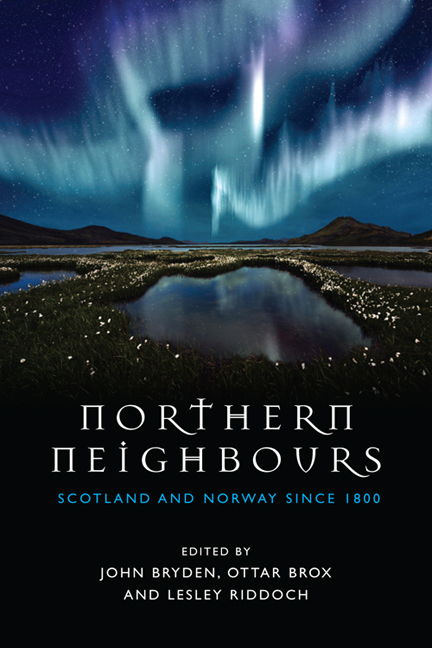Book contents
- Frontmatter
- Contents
- Acknowledgements
- Foreword
- 1 Introduction
- 2 Towards a Theory of Divergent Development
- 3 Cousins Divided? Development in and of Political Institutions in Scotland and Norway since 1814
- 4 Agrarian Change in Scotland and Norway: Agricultural Production, Structures, Politics and Policies since 1800
- 5 The Evolution of Local Government and Governance in Scotland and Norway
- 6 The Development of Industry and North Sea Oil in Scotland and Norway
- 7 Reflections on the Making of Norway
- 8 Money and Banking in Scotland and Norway
- 9 Religion in Scotland and Norway
- 10 The Nordic Welfare Model in Norway and Scotland
- 11 Access, Nature, Culture and the Great Outdoors – Norway and Scotland
- 12 Education in Norway and Scotland: Developing and Re-forming the Systems
- 13 Norway and the United Kingdom/Scotland after the Second World War
- 14 Conclusions
- The Contributors
- Bibliography
- Index
10 - The Nordic Welfare Model in Norway and Scotland
Published online by Cambridge University Press: 05 August 2016
- Frontmatter
- Contents
- Acknowledgements
- Foreword
- 1 Introduction
- 2 Towards a Theory of Divergent Development
- 3 Cousins Divided? Development in and of Political Institutions in Scotland and Norway since 1814
- 4 Agrarian Change in Scotland and Norway: Agricultural Production, Structures, Politics and Policies since 1800
- 5 The Evolution of Local Government and Governance in Scotland and Norway
- 6 The Development of Industry and North Sea Oil in Scotland and Norway
- 7 Reflections on the Making of Norway
- 8 Money and Banking in Scotland and Norway
- 9 Religion in Scotland and Norway
- 10 The Nordic Welfare Model in Norway and Scotland
- 11 Access, Nature, Culture and the Great Outdoors – Norway and Scotland
- 12 Education in Norway and Scotland: Developing and Re-forming the Systems
- 13 Norway and the United Kingdom/Scotland after the Second World War
- 14 Conclusions
- The Contributors
- Bibliography
- Index
Summary
INTRODUCTION
More than a Millennium ago, Vikings first invaded and then controlled whole swaths of what is now Scotland. The Norsemen were in charge of the Orkneys, Shetland, the Hebrides, Caithness and Sutherland for several hundred years. Now Scotland could be looking to establish itself along the lines of a Nordic model once more. Parts of the Scottish National party, in their quest for independence, are keen to place Scotland alongside the likes of Norway, Sweden and Denmark by adopting similar social and economic policies.
The idea of Scotland seeking to ‘establish itself along the lines of a Nordic model’, here reported by the Financial Times correspondent Richard Milne, has been a regular trope in Scottish political discourse, both before and after the reestablishment of the Scottish Parliament in 1999. Milne's article, written in the run-up to the 2014 independence referendum, demonstrates most of the classic elements of this discourse (as well as the slightly odd implication that ‘Scotland’ sought previously, a ‘millennium ago’, to establish a Nordic model via Norse invasion). He notes the ‘superficial similarities’ between Scotland and Scandinavia, such as geographical proximity in Northern Europe, borrowed linguistic elements in Scots, ‘relatively small’ populations, and a shared dourness underpinned by a particular religious outlook. None of this is new, although the apparently enduring Norwegian success story has led some supporters of Scottish independence to idealise Norway as a model. Conversely, opponents have highlighted the very distinct circumstances around Norway's Oil Fund, which have allowed high levels of public spending to create a social welfare blueprint that is the envy of many ‘social democratic’ onlookers.
The Nordic region has played a prominent role in the debates on Scottish independence for over four decades. Prior to the 1979 Scottish Referendum, and again in the 1990s, Nordic states provided examples of ‘successful’ countries which gave a rhetorical counterbalance to the ‘great power’ discourse of the British State. In addition to this constitutional comparison, it is clear that – particularly in the 1990s and the period of ‘democratic deficit’ during the Thatcher years – the idealised notion of a Nordic welfare model provided a fascinating example for many Scottish politicians. On the independence side, the SNP had its own ‘social democratic’ wing, which eventually gained internal party hegemony, aspiring to perceived Nordic ideals of social equality.
- Type
- Chapter
- Information
- Northern NeighboursScotland and Norway since 1800, pp. 211 - 229Publisher: Edinburgh University PressPrint publication year: 2015



